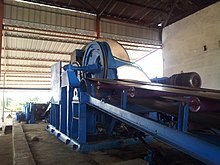

A decorticator (from Latin: cortex, bark) is a machine for stripping the skin, bark, or rind off nuts, wood, plant stalks, grain, etc., in preparation for further processing.
History
In 1933, a farmer named Bernagozzi from Bologna manufactured a machine called a "scavezzatrice", a decorticator for hemp. [1] A working hemp decorticator from 1890, manufactured in Germany, is preserved in a museum in Bologna. [2]
In Italy, the"scavezzatrice" faded in the 1950s because of monopolisation from fossil fuel, paper interests, synthetic materials and from other less profitable crops.
Many types of decorticators have been developed since 1890. [3]
In 1919, George Schlichten received a U.S. patent on his improvements of the decorticator for treating fiber bearing plants. [4] Schlichten failed to find investors for production of his decorticator and died in 1923, a broken man. His business was revived a decade after death in 1933. [5] [6]
Newer, high-speed kinematic decorticators, use a different mechanism, enabling separation into three streams; bast fibre, hurd, and green microfiber. [7]
Current usage
In some decorticators, the operation is "semi-automatic", featuring several stops during operation, while more modern systems, such as high-speed kinematic decorticators, are fully automatic.
There are companies who produce and sell decorticators for different crops. [8] [9]
References
- ^ Paolo Ranalli and Gianpietro Venturi: Hemp as a raw material for industrial applications, Euphytica, Euphytica 140: 1–6, 2004.
- ^ Picture of an 1890 GERMAN DECORTICATOR at Museo Della Civilta Contadina, San Marino Di Bentivoglio, Bologna, Italy.
- ^ Pictures of many decorticators in Internet
- ^ George W Schlichten, 1919
- ^ History of hemp prohibition
- ^ US 2463278, V, Johansen John & C, Westergaard Carl, "Control mechanism for decorticating machines", published Mar 1, 1949
- ^ Canadian Greenfield Technologies Inc.; HempTrain
- ^ Canadian Greenfield Technologies Inc.; Decorticators
- ^ GOYUM; Decorticators